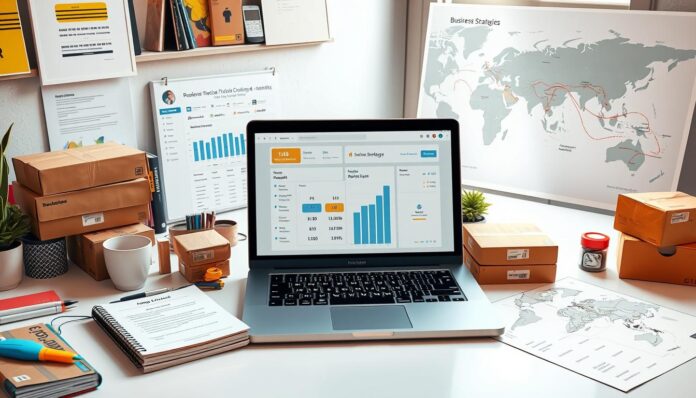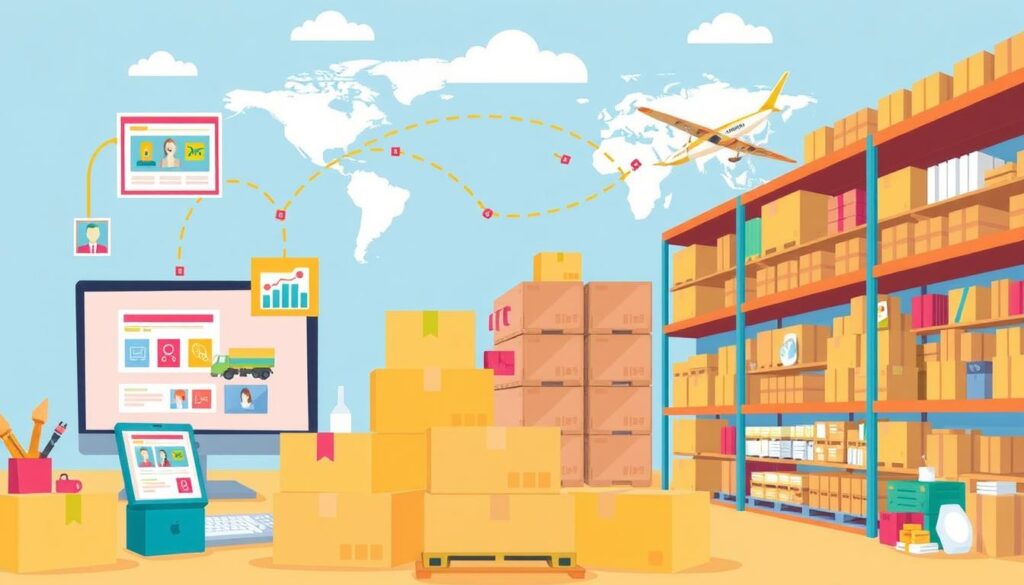Imagine waking up to an email from a customer excitedly placing an order on your online store. You didn’t handle inventory, package any products, or even ship them. This is the magic of dropshipping! It’s a modern way to run an online business with little money down and no inventory worries.
The dropshipping industry is booming, with a projected market size of $476.1 billion by 2026. This is the perfect time to start. This guide is for beginners who want to learn how to set up their online shop and master the dropshipping model. It shows how to make the most of this flexible approach.
Dropshipping lets you quickly turn ideas into reality, without the hassle of traditional retail. With this guide, you’ll learn how to find profitable niches and execute smart marketing strategies. Get ready to succeed in the exciting world of dropshipping!
Table of Contents
Key Takeaways
- Dropshipping requires no upfront investment in inventory.
- A wide variety of products can be offered without storage concerns.
- Most of the work can be completed from home and automated.
- Effective marketing is key for driving sales in dropshipping.
- Choosing reliable suppliers and high-quality products is essential.
- Understanding market trends and competition is vital.
What Is Dropshipping?
Dropshipping is a big hit in today’s ecommerce world. It lets you start an online store without keeping any products in stock. Instead, you get products from suppliers who ship them straight to your customers. This is great for beginners because it’s easy to start and doesn’t require a lot of inventory.
Definition and Overview
In dropshipping, you sell products and take orders without having to store anything. When someone buys something, you send the order to your supplier. They then ship the product to the customer. This way, you can sell lots of products without worrying about storage space.
Actually, about 30% of all online stores use dropshipping. It’s a popular choice because it’s easy to get started.
How Dropshipping Differs from Traditional Ecommerce
The main difference between dropshipping and traditional ecommerce is how you handle inventory. With traditional ecommerce, you buy and store products before selling them. This can be risky and expensive, making it hard for new businesses.
Dropshipping, on the other hand, lets you start with little to no upfront costs. This makes it easier for new businesses to get into the market. Knowing the difference between dropshipping and traditional ecommerce can help you decide which is best for you.
How Does Dropshipping Work?
Dropshipping works through several stages that make the order process smooth. It lets businesses start with little money and offer many products. Knowing how it works is key to being successful.
Order Fulfillment Process
The order fulfillment process is key to dropshipping success. It involves these steps:
- The customer places an order on your online store.
- You forward the order to the dropshipper or supplier.
- The dropshipper ships the product directly to the customer.
This way, you don’t have to handle products yourself. You can focus on marketing and sales. Dropshipping lets you work with many suppliers, making it easy to change your product list based on demand.
Payment and Profit Margins
It’s important to understand how payments and profits work. In dropshipping, you buy products at wholesale and sell them at retail. For example, if you buy a product for £70 and sell it for £100, you make £30 profit. This model is great for starting a business because it doesn’t require a lot of money upfront.
Even though dropshipping saves on costs like storage, it might have lower profit margins. Sometimes, net margins can be as low as 10%. To keep your prices right, consider the market and shipping costs. Good dropshipping strategies can help you make more money while keeping customers happy.
Advantages and Disadvantages of Dropshipping
Dropshipping offers both benefits and challenges. Knowing these is key to a successful business plan. By looking at the good and bad sides, you can move forward in this changing field.
Benefits of Starting a Dropshipping Business
One big plus is the low start-up cost. You don’t have to buy a lot of products upfront. This means you don’t worry about unsold items.
It also lets you work from anywhere. This is great for those who want to run a business without being tied to one place.
Adding new products is easy. You can offer many items without worrying about inventory. This way, you can test new products without big risks.
Another benefit is saving time. Dropshipping handles many tasks for you. This lets you focus on growing and marketing your business. Tools like AutoDS can make things even better, helping you grow faster.
Potential Challenges to Consider
But, there are challenges too. Dealing with many suppliers can be hard. Each one has its own way of handling orders and shipping. This can slow down your service, hurting your reputation.
Answering customer questions without knowing the products well can be tough. Also, relying on suppliers for customer service can slow down solving problems.
The market is competitive, and profits can be low. Finding good suppliers is key. Problems like stock shortages can upset customers and hurt your sales. Knowing these challenges helps you prepare for your dropshipping journey.
Dropshipping Business Guide: Starting Your Online Store
Starting a dropshipping store needs a solid plan. First, do a deep market analysis to find out what’s popular now. Use tools like Google Trends and Facebook Audience Insights to see what people want. This helps you pick a niche that fits well with your audience.
Step 1: Analyze the Market
Begin by looking at the competition and finding your spot. Knowing what customers like is key to success. Keep an eye on rivals through social media, online stores, and Google to improve your game.
Step 2: Select a Niche
After getting insights, pick a niche that matches your audience. This choice affects your products and how you market them. Go for niches with steady or growing interest for better sales and keeping customers.
Step 3: Choose Dropshipping Products
When picking products, use what you learned and your niche choice. Tools like DSers and AliShark help find trending items. Make sure to check if suppliers are reliable and their prices are good for your profit.






